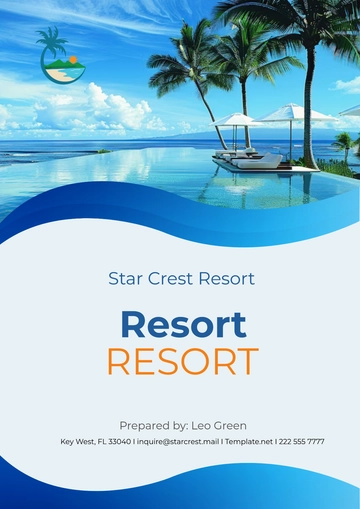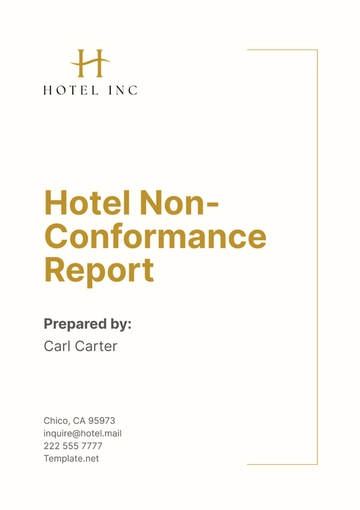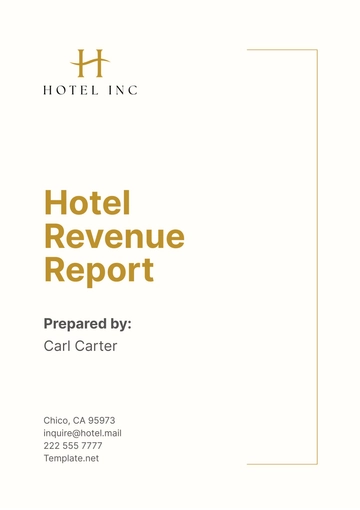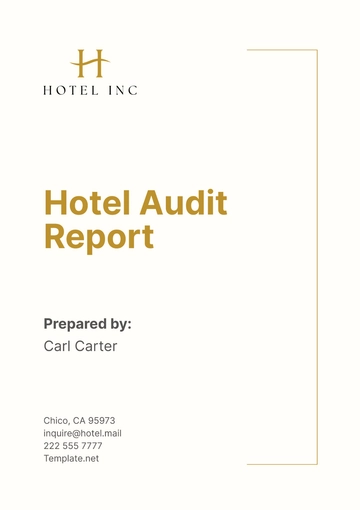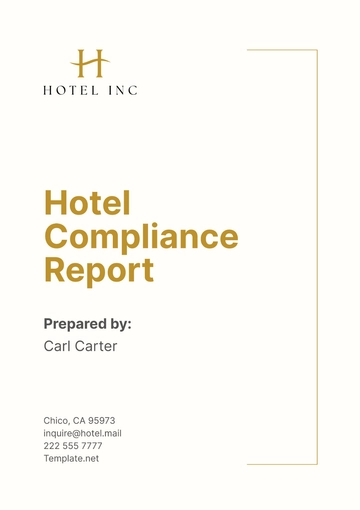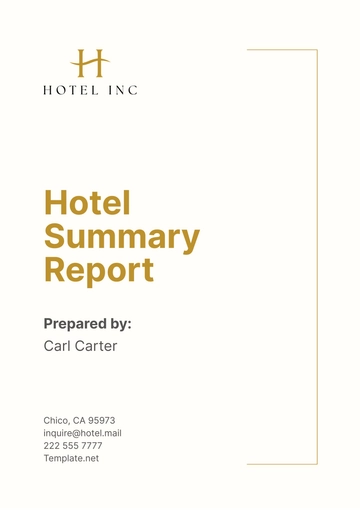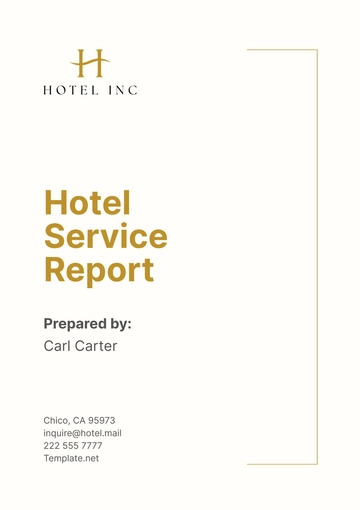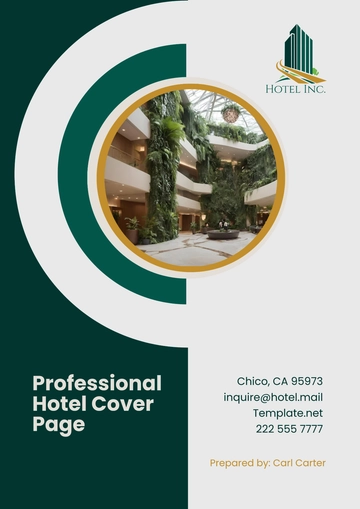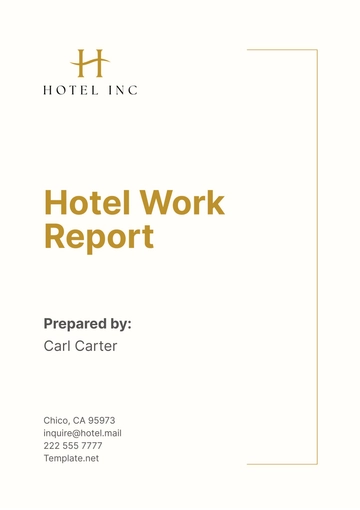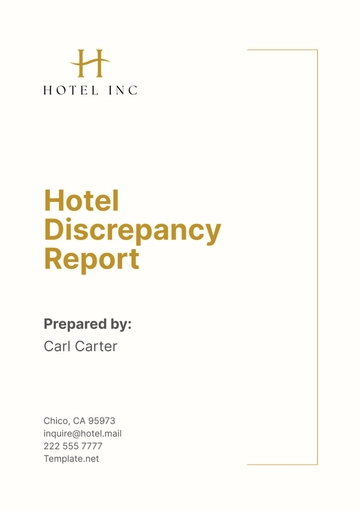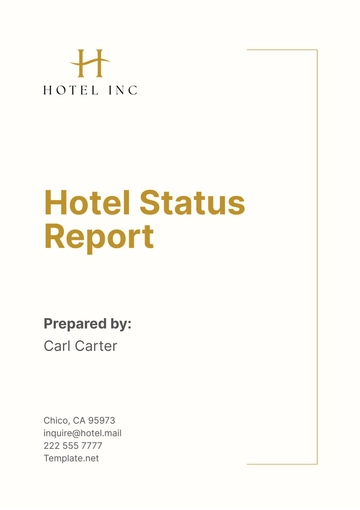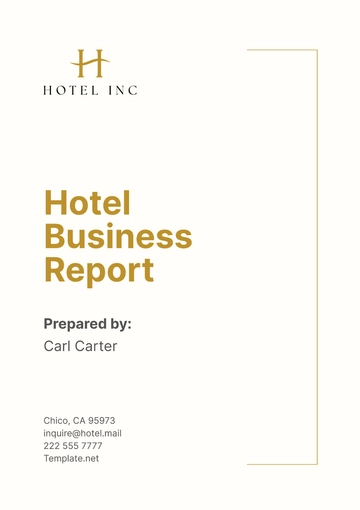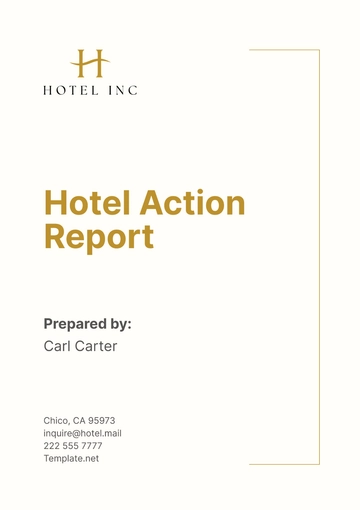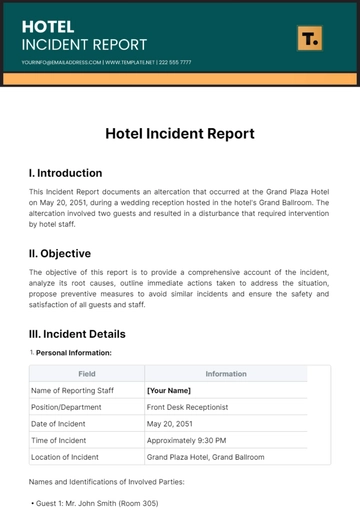Free Hotel Sales Report
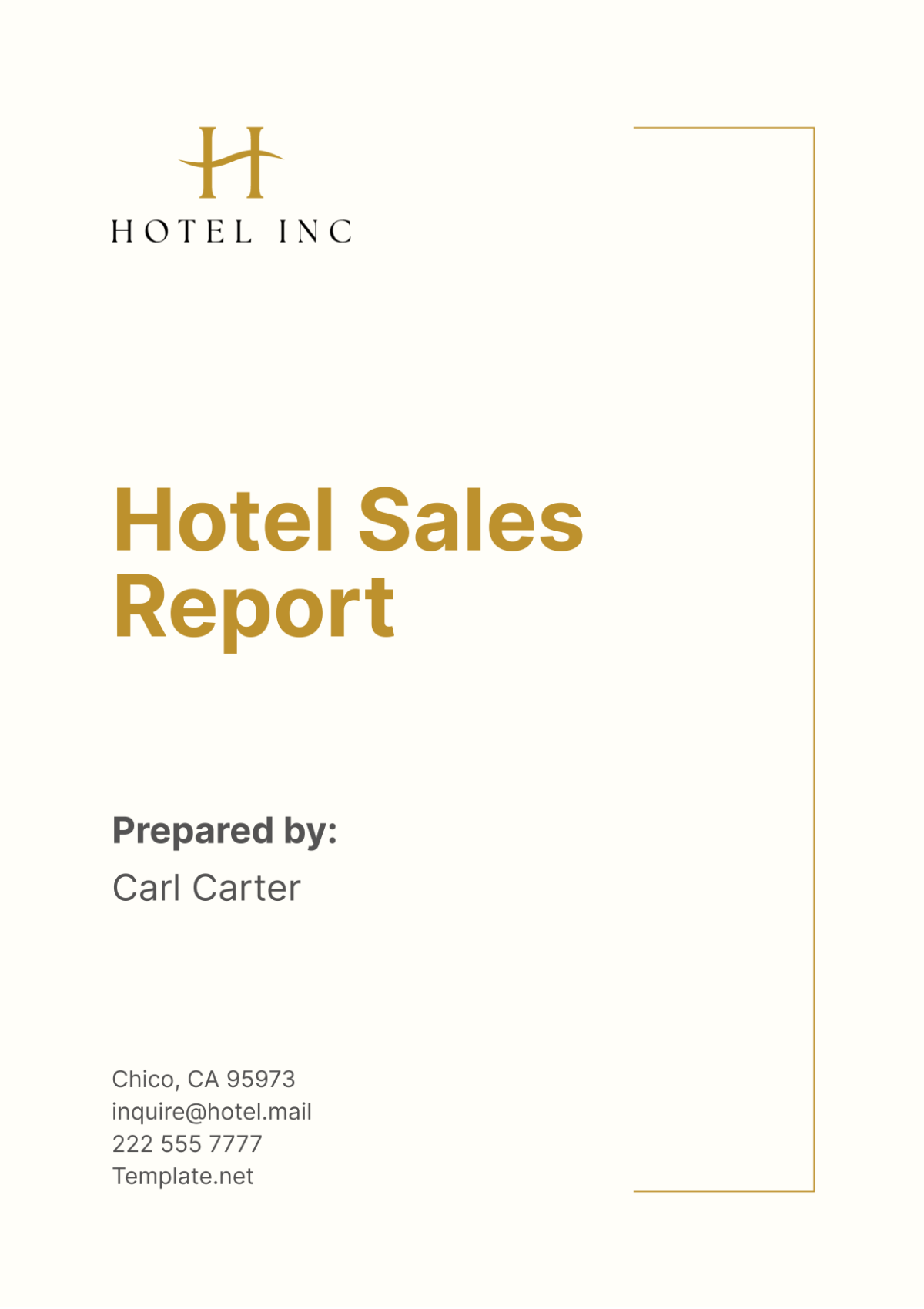
I. Executive Summary
This sales report provides an in-depth analysis of the hotel sales performance for [Your Company Name] for the period from January 1, 2050, to December 31, 2050. The year 2050 marked a significant phase in our hotel’s journey towards achieving excellence in hospitality and service. Throughout the year, our hotel has seen substantial growth in various areas, contributing to our overall success. This report aims to highlight these achievements, identify trends, and provide a foundation for strategic planning in the coming years.
Key Highlights
Overall Sales Growth: Our hotel experienced a 15% growth in overall sales compared to the previous year. This increase is attributed to effective marketing strategies, enhanced guest services, and targeted promotional activities.
Increase in Direct Bookings: Direct bookings saw a remarkable increase of 20%. This growth is a result of our focused efforts on improving our online presence, offering exclusive deals on our website, and strengthening customer relationships.
Occupancy Rate: The average occupancy rate for the year was 75%. This is a positive indicator of our hotel’s popularity and guest satisfaction, reflecting our ability to attract and retain customers.
II. Sales Performance
A comprehensive analysis of our sales performance is essential to understand the trends and areas of improvement. The data below provides a detailed breakdown of our monthly and quarterly sales, highlighting our hotel’s financial health and operational success.
A. Monthly Sales Breakdown
The table below provides a detailed breakdown of monthly sales and occupancy rates for the year 2050. This analysis helps in identifying peak seasons and understanding guest behavior throughout the year.
Month | Total Sales | Occupancy Rate |
|---|---|---|
January | $150,000 | 70% |
February | $145,000 | 68% |
March | $160,000 | 78% |
April | $155,000 | 72% |
May | $165,000 | 74% |
June | $170,000 | 76% |
July | $180,000 | 80% |
August | $175,000 | 77% |
September | $170,000 | 75% |
October | $165,000 | 73% |
November | $160,000 | 71% |
December | $175,000 | 79% |
Analysis
January and February: The initial months saw moderate sales and occupancy rates, typical of the post-holiday season. However, our Winter Wonderland promotion contributed to maintaining a steady flow of guests.
March: The increase in March can be attributed to the beginning of the spring travel season and successful marketing campaigns targeting families and spring break travelers.
Summer Months (June to August): As expected, the summer months saw the highest sales and occupancy rates, with July peaking at 80%. This is due to the school vacation period and our Summer Package Promotion, which attracted a large number of leisure travelers.
Fall and Winter Months: The fall season showed a slight decline in sales, but the trend picked up again in December due to the New Year’s Eve Special, achieving an impressive 79% occupancy rate.
B. Quarterly Comparison
Analyzing sales on a quarterly basis provides a broader view of our financial performance and helps in planning for seasonal variations.
Quarter | Total Sales |
|---|---|
Q1 | $455,000 |
Q2 | $480,000 |
Q3 | $510,000 |
Q4 | $520,000 |
Analysis
Q1 (January to March): The first quarter generated $455,000 in sales, driven by steady occupancy rates and successful spring promotions. The increase towards the end of the quarter highlights the effectiveness of targeted marketing efforts.
Q2 (April to June): Sales improved in the second quarter, reaching $480,000. The introduction of new amenities and the launch of early summer promotions contributed to this growth.
Q3 (July to September): The third quarter was the most lucrative, with sales reaching $510,000. This peak is a direct result of the high summer season and successful execution of the Summer Package Promotion.
Q4 (October to December): The final quarter maintained the upward trend, closing the year with $520,000 in sales. The New Year’s Eve Special and holiday season activities were key drivers for this growth.
III. Client Segmentation
Understanding our client base is crucial for tailoring our services and marketing strategies. This section provides insights into the sources of our bookings and the market segments we cater to.
A. Booking Sources
Our analysis of booking sources reveals the following distribution for 2050:
Direct Bookings: 40%
Online Travel Agencies (OTAs): 35%
Corporate Clients: 15%
Walk-ins: 10%
Analysis
Direct Bookings: A significant portion of our sales (40%) came from direct bookings. This reflects our successful efforts in enhancing our online booking system and offering attractive deals exclusive to our website visitors. Direct bookings are highly beneficial as they often have higher margins due to the absence of third-party commission fees.
Online Travel Agencies: OTAs contributed to 35% of our bookings. While they play a vital role in driving traffic, our goal is to gradually reduce dependency on OTAs by boosting direct bookings through loyalty programs and targeted marketing.
Corporate Clients: Corporate bookings accounted for 15% of our total bookings. This segment is crucial as it provides a steady flow of business throughout the year. Strengthening relationships with corporate clients and expanding our meeting and event services are key to growing this segment.
Walk-ins: Although walk-ins represent only 10% of our bookings, they are important for filling last-minute vacancies and maximizing occupancy rates.
B. Market Segments
Our client base can be broadly categorized into the following market segments:
Leisure Travelers: 50%
Business Travelers: 30%
Group Bookings: 20%
Analysis
Leisure Travelers: Half of our guests are leisure travelers, who typically stay during weekends, holidays, and vacation seasons. Our targeted promotions and family-friendly amenities have been successful in attracting this segment. We will continue to enhance our offerings to cater to the needs of leisure travelers, such as family packages and adventure tours.
Business Travelers: Business travelers make up 30% of our clientele. This segment is vital for maintaining occupancy during off-peak seasons. Offering business-centric amenities such as high-speed internet, meeting rooms, and business centers has been effective. We plan to introduce more services tailored for business travelers to increase their satisfaction and loyalty.
Group Bookings: Group bookings, which include events like weddings, conferences, and tour groups, account for 20% of our bookings. These are highly profitable due to the multiple room nights and additional services utilized. Our focus will be on expanding our group booking capabilities and enhancing our event management services to attract more large-scale bookings.
IV. Key Metrics
A. Average Daily Rate (ADR)
The Average Daily Rate (ADR) for 2050 was $120, reflecting a 10% increase from the previous year. This significant rise in ADR indicates our success in implementing strategies aimed at attracting guests willing to pay higher rates for enhanced services.
Analysis of ADR Trends
Seasonal Pricing Adjustments: Throughout the year, we strategically adjusted our room rates based on demand, seasonal trends, and local events. For instance, during peak seasons such as summer and the holiday period in December, room rates were increased to capitalize on the high demand, contributing to the overall rise in ADR.
Enhanced Service Offerings: The introduction of new amenities and premium services, such as upgraded room features, exclusive dining options, and personalized concierge services, justified the higher rates. These enhancements not only attracted more affluent guests but also encouraged longer stays, further boosting our ADR.
Targeted Marketing Campaigns: Our focused marketing efforts, particularly the Summer Package Promotion and the New Year’s Eve Special, played a crucial role in attracting guests willing to pay premium prices. By highlighting unique experiences and exclusive deals, we effectively communicated the value proposition of staying at our hotel.
B. Revenue per Available Room (RevPAR)
The Revenue per Available Room (RevPAR) for 2050 was $90. RevPAR is a critical metric that combines both occupancy and ADR to provide a comprehensive measure of room revenue performance.
Analysis of RevPAR Trends
Occupancy and ADR Synergy: The combination of a 75% occupancy rate and an ADR of $120 resulted in a healthy RevPAR of $90. This synergy highlights our ability to maintain high room occupancy while also increasing the rate per occupied room, thus optimizing revenue generation.
Operational Efficiency: Effective management of room availability and pricing strategies ensured that we maximized revenue from our available rooms. Our dynamic pricing model, which adjusts rates based on real-time demand and occupancy forecasts, was instrumental in achieving this balance.
Guest Satisfaction and Loyalty: High guest satisfaction scores and repeat bookings contributed to stable occupancy rates, which in turn positively impacted RevPAR. Our loyalty programs and personalized guest experiences fostered strong relationships with returning guests, ensuring a steady revenue stream.
V. Sales Initiatives and Strategies
A. Marketing Campaigns
In 2050, we launched several marketing campaigns that significantly impacted our sales performance and guest engagement.
Summer Package Promotion: This campaign was designed to attract families and leisure travelers during the peak summer season. By offering bundled packages that included discounted room rates, complimentary meals, and access to recreational activities, we saw a 25% increase in summer bookings. This campaign not only boosted our occupancy rates but also enhanced guest satisfaction by providing added value.
New Year’s Eve Special: The New Year’s Eve Special was a targeted campaign aimed at attracting guests for the holiday season. By offering a festive package that included a gala dinner, live entertainment, and midnight celebrations, we achieved an 80% occupancy rate on December 31. This campaign showcased our ability to create memorable experiences, driving high guest turnout during a competitive period.
B. Partnership Development
Developing strategic partnerships was another key component of our sales strategy in 2050.
Travel Agencies: We secured partnerships with leading travel agencies to expand our reach and attract a broader audience. These partnerships included exclusive deals and promotions for agency clients, driving a steady flow of bookings. By collaborating with well-established agencies, we enhanced our credibility and visibility in the market.
Local Businesses: Partnering with local businesses allowed us to offer unique experiences to our guests, such as guided tours, local cuisine tastings, and cultural events. These partnerships not only enriched our guest offerings but also supported the local economy, fostering positive community relations.
VI. Conclusion and Recommendations
Summary of Achievements
The year 2050 was marked by significant achievements for [Your Company Name], with notable growth in sales and improved occupancy rates. Our strategic initiatives, including targeted marketing campaigns and strategic partnerships, have successfully strengthened our market position. The increase in ADR and RevPAR reflects our ability to attract higher-paying guests and optimize room revenue.
Recommendations for Continued Growth
Enhance Online Booking Systems: To further boost direct bookings, we recommend investing in the enhancement of our online booking systems. This includes improving the user interface, offering personalized booking experiences, and integrating seamless payment options. A user-friendly and efficient online platform will attract more guests and encourage direct bookings, reducing dependency on third-party agencies.
Expand Corporate Partnerships: Building more relationships with corporate clients will help secure regular business travel bookings. This can be achieved by offering tailored corporate packages, loyalty programs, and exclusive deals for long-term stays. Expanding our corporate client base will provide a steady stream of bookings throughout the year, especially during off-peak seasons.
Invest in Targeted Marketing Campaigns: Developing and implementing targeted marketing strategies aimed at specific market segments, such as millennials, international travelers, and high-net-worth individuals, will attract a diverse guest base. Utilizing data analytics to understand guest preferences and behavior will enable us to create personalized and effective marketing campaigns.
Action Plan
To implement these recommendations, we propose the following action plan:
Enhancement of Online Booking Systems
Timeline: Q1 2051
Budget: $50,000
Responsible Department: IT and Marketing
Expansion of Corporate Partnerships
Timeline: Q2 2051
Budget: $30,000
Responsible Department: Sales and Marketing
Targeted Marketing Campaigns
Timeline: Throughout 2051
Budget: $100,000
Responsible Department: Marketing
Contact Information
For further details or inquiries, please contact:
[Your Name]
Email: [Your Email]
Phone: [Your Company Number]
- 100% Customizable, free editor
- Access 1 Million+ Templates, photo’s & graphics
- Download or share as a template
- Click and replace photos, graphics, text, backgrounds
- Resize, crop, AI write & more
- Access advanced editor
Elevate your hotel's financial insights with the Hotel Sales Report Template from Template.net. This meticulously crafted template offers a comprehensive overview of your property's sales performance, enabling data-driven decisions for growth. Editable and customizable with our AI editor tool, effortlessly tailor it to your hotel's unique needs. Streamline your reporting process and maximize profitability today!
You may also like
- Sales Report
- Daily Report
- Project Report
- Business Report
- Weekly Report
- Incident Report
- Annual Report
- Report Layout
- Report Design
- Progress Report
- Marketing Report
- Company Report
- Monthly Report
- Audit Report
- Status Report
- School Report
- Reports Hr
- Management Report
- Project Status Report
- Handover Report
- Health And Safety Report
- Restaurant Report
- Construction Report
- Research Report
- Evaluation Report
- Investigation Report
- Employee Report
- Advertising Report
- Weekly Status Report
- Project Management Report
- Finance Report
- Service Report
- Technical Report
- Meeting Report
- Quarterly Report
- Inspection Report
- Medical Report
- Test Report
- Summary Report
- Inventory Report
- Valuation Report
- Operations Report
- Payroll Report
- Training Report
- Job Report
- Case Report
- Performance Report
- Board Report
- Internal Audit Report
- Student Report
- Monthly Management Report
- Small Business Report
- Accident Report
- Call Center Report
- Activity Report
- IT and Software Report
- Internship Report
- Visit Report
- Product Report
- Book Report
- Property Report
- Recruitment Report
- University Report
- Event Report
- SEO Report
- Conference Report
- Narrative Report
- Nursing Home Report
- Preschool Report
- Call Report
- Customer Report
- Employee Incident Report
- Accomplishment Report
- Social Media Report
- Work From Home Report
- Security Report
- Damage Report
- Quality Report
- Internal Report
- Nurse Report
- Real Estate Report
- Hotel Report
- Equipment Report
- Credit Report
- Field Report
- Non Profit Report
- Maintenance Report
- News Report
- Survey Report
- Executive Report
- Law Firm Report
- Advertising Agency Report
- Interior Design Report
- Travel Agency Report
- Stock Report
- Salon Report
- Bug Report
- Workplace Report
- Action Report
- Investor Report
- Cleaning Services Report
- Consulting Report
- Freelancer Report
- Site Visit Report
- Trip Report
- Classroom Observation Report
- Vehicle Report
- Final Report
- Software Report
